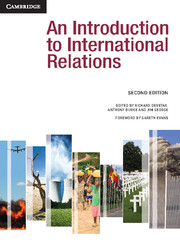Book contents
- Frontmatter
- Contents
- Tables, Figures and Boxes
- Contributors
- Preface and acknowledgements
- An Introduction to International Relations: The origins and changing agendas of a discipline
- 1 Theories of International Relations
- 2 The Traditional Agenda
- 3 The New Agenda
- 21 The United Nations
- 22 Non-State Actors: Multinational Corporations and International Non-Governmental Organisations
- 23 Religion and Secularism
- 24 Global Economic Institutions
- 25 Global Trade
- 26 Global Finance
- 27 Global Poverty, Inequality and Development
- 28 Globalisation and Its Critics
- 29 Global Terrorism
- 30 Post-Conflict State-Building
- 31 Humanitarian Intervention
- 32 Human Rights
- 33 Migration and Refugees
- 34 Global Environmental Politics
- 35 Climate Change
- Glossary of Terms
- Bibliography
- Index
- References
31 - Humanitarian Intervention
from 3 - The New Agenda
- Frontmatter
- Contents
- Tables, Figures and Boxes
- Contributors
- Preface and acknowledgements
- An Introduction to International Relations: The origins and changing agendas of a discipline
- 1 Theories of International Relations
- 2 The Traditional Agenda
- 3 The New Agenda
- 21 The United Nations
- 22 Non-State Actors: Multinational Corporations and International Non-Governmental Organisations
- 23 Religion and Secularism
- 24 Global Economic Institutions
- 25 Global Trade
- 26 Global Finance
- 27 Global Poverty, Inequality and Development
- 28 Globalisation and Its Critics
- 29 Global Terrorism
- 30 Post-Conflict State-Building
- 31 Humanitarian Intervention
- 32 Human Rights
- 33 Migration and Refugees
- 34 Global Environmental Politics
- 35 Climate Change
- Glossary of Terms
- Bibliography
- Index
- References
Summary
Introduction
This chapter introduces students to an idea which has enjoyed a remarkable, if hotly contested, development in the post-Cold War era: humanitarian intervention. Based on a commitment to principles of humanity, humanitarian intervention seeks to alleviate the unnecessary human suffering caused by violent conflict by intervening in another state with force under certain limited conditions. The chapter first outlines the origins of humanitarianism; second, it sketches a short history of humanitarian intervention; and third, it discusses the shift from humanitarian intervention to responsibility to protect (R2P). As the context of world politics becomes ever more complex, debate about global responsibilities to protect suffering strangers through humanitarian action will continue to shape the theory and practice of international relations.
For the last two decades, humanitarian organisations have careened from one major disaster to another. The end of the Cold War unleashed a pent-up demand for acute humanitarian action – that is, protecting and assisting individuals caught in war zones. Analyses of this period typically highlight three defining trends that explain this expansion, as well as second thoughts about the overall direction (Barnett and Weiss 2011). The first is the growing willingness and ability of outsiders to help those at risk. Radical improvements in information technology and logistical capacities, growing international support for coming to the rescue of victims, multiplying numbers of relief organisations, and substantial increases in available resources promised an enhanced collective capacity to provide relief, rescue and reconstruction. The second trend reflects the mounting dangers that aid workers confront in war zones where access is difficult, where they are often perceived as a threat or as a resource to be captured, where their own physical safety is in doubt, and where civilian populations are the intended victims (Kaldor 1999; Duffield 2001). In addition, the deployment of military force in such arenas for human protection purposes has raised new kinds of questions about the ability of aid workers to remain faithful to their principles (Hoffman and Weiss 2006).
- Type
- Chapter
- Information
- An Introduction to International Relations , pp. 426 - 439Publisher: Cambridge University PressPrint publication year: 2011
References
- 4
- Cited by



